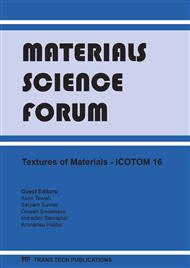[1]
Kuzel, R., Janecek, M., Matej, Z., Cizek, J., Dopita, M., and Srba, O., Microstructure of Equal-Channel Angular Pressed Cu and Cu-Zr Samples Studied by Different Methods, Metallurgical and Materials Transactions A-Physical Metallurgy and Materials Science, 41(2010).
DOI: 10.1007/s11661-009-9895-0
Google Scholar
[2]
Shankar, M. R., Rao, B. C., Lee, S., Chandrasekar, S., King, A. H., and Compton, W. D., Severe Plastic Deformation (SPD) of Titanium at near-Ambient Temperature, Acta Materialia, 54 (2006) 3691-3700.
DOI: 10.1016/j.actamat.2006.03.056
Google Scholar
[3]
Shekhar, S., Cai, J., Wang, J., and Shankar, M. R., Multimodal Ultrafine Grain Size Distributions from Severe Plastic Deformation at High Strain Rates, Materials Science and Engineering a-Structural Materials Properties Microstructure and Processing, 527 (2009).
DOI: 10.1016/j.msea.2009.07.058
Google Scholar
[4]
Huang, C., Murthy, T. G., Shankar, M. R., M'saoubi, R., and Chandrasekar, S., Temperature Rise in Severe Plastic Deformation of Titanium at Small Strain-Rates, Scripta Materialia, 58 (2008) 663-666.
DOI: 10.1016/j.scriptamat.2007.11.042
Google Scholar
[5]
Wang, Y. M., Chen, M. W., Zhou, F. H., and Ma, E., High Tensile Ductility in a Nanostructured Metal, Nature, 419 (2002) 912-915.
DOI: 10.1038/nature01133
Google Scholar
[6]
Li, Y. S., Tao, N. R., and Lu, K., Microstructural Evolution and Nanostructure Formation in Copper During Dynamic Plastic Deformation at Cryogenic Temperatures, Acta Materialia, 56 (2008) 230-241.
DOI: 10.1016/j.actamat.2007.09.020
Google Scholar
[7]
Oxley, P. L. B., and Hasting, W. F., Predicting the Strain Rate in the Zone of Intense Shear in Which the Chip Is Formed in Machining from the Dynamic Flow Stress Properties of the Work Material and the Cutting Conditions, Proceedings of the Royal Society of London Series a-Mathematical and Physical Sciences, 356 (1977).
DOI: 10.1098/rspa.1977.0141
Google Scholar
[8]
Komanduri, R., and Hou, Z. B. Thermal Modeling of the Metal Cutting Process - Part I - Temperature Rise Distribution Due to Shear Plane Heat Source, International Journal of Mechanical Sciences, 42 (2000) 1715-1752.
DOI: 10.1016/s0020-7403(99)00105-8
Google Scholar
[9]
Shekhar, S., Abolghasem, S., Basu, S., Cai, J., and Shankar, M. R., Effect of Severe Plastic Deformation in Machining Elucidated Via Rate-Strain-Microstructure (Rsm) Mappings, Journal of Manufacturing Science and Engineering-Transactions of the Asme, Accepted for publication (2011).
DOI: 10.1115/1.4006549
Google Scholar
[10]
Zener, C., and Hollomon, J. H., Effect of Strain Rate Upon Plastic Flow of Steel, Journal of Applied Physics, 15 (1944) 22-33.
DOI: 10.1063/1.1707363
Google Scholar
[11]
Jata, K. V., and Semiatin, S. L., 2000, Continuous Dynamic Recrystallization During Friction Stir Welding of High Strength Aluminum Alloys, Scripta Materialia, 43 (2000) 743-749.
DOI: 10.1016/s1359-6462(00)00480-2
Google Scholar
[12]
Mcqueen, H. J., and Jonas, J. J., Recent Advances in Hot Working: Fundamental Dynamic Softening Mechanisms, " Journal of Applied MetalWorking, 3 (1984) 233-241.
DOI: 10.1007/bf02833651
Google Scholar
[13]
Humphreys, F. J., and Hatherly, M., Recrystallization and Related Annealing Phenomena, Elsevier, New York (2004).
Google Scholar
[14]
Ahlborn, H., Hornbogen, E., and Koster, U., Recrystallization Mechanism and Annealing Texture in Aluminum-Copper Alloys, Journal of Materials Science, 4 (1969) 944-950.
DOI: 10.1007/bf00555308
Google Scholar
[15]
Montheillet, F., and Le Coze, J., "Influence of Purity on the Dynamic Recrystallization of Metals and Alloys, Physica Status Solidi a-Applied Research, 189 (2002) 51-58.
DOI: 10.1002/1521-396x(200201)189:1<51::aid-pssa51>3.0.co;2-m
Google Scholar
[16]
Matsuki, K., Uetani, Y., Yamada, M., and Murakami, Y., Superplasticity in an Al-6 Wt % Mg Alloy, Metal Science, 10 (1976) 235-242.
DOI: 10.1179/030634576790432425
Google Scholar
[17]
Skrotzki, W., Scheerbaum, N., Oertel, C. G., Arruffat-Massion, R., Suwas, S., and Toth, L. S., Microstructure and Texture Gradient in Copper Deformed by Equal Channel Angular Pressing, Acta Materialia, 55 (2007) 2013-(2024).
DOI: 10.1016/j.actamat.2006.11.005
Google Scholar
[18]
Gurao, N. P., Kapoor, R., and Suwas, S., Effect of Strain Rate on Evolution of the Deformation Microstructure and Texture in Polycrystalline Copper and Nickel, Metallurgical and Materials Transactions a-Physical Metallurgy and Materials Science, 41A (2010).
DOI: 10.1007/s11661-010-0360-x
Google Scholar


